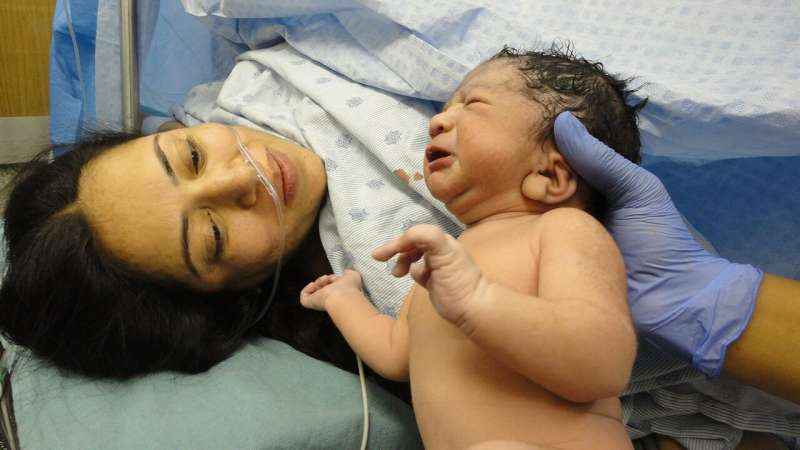This article has been reviewed according to Science X's editorial process and policies. Editors have highlighted the following attributes while ensuring the content's credibility:
fact-checked
peer-reviewed publication
trusted source
proofread
Imaging tech produces real-time 3D maps of uterine contractions during labor

Researchers at Washington University School of Medicine in St. Louis have developed new imaging technology that can produce 3D maps showing the magnitude and distribution of uterine contractions in real time and across the entire surface of the uterus during labor. Building on imaging methods long used on the heart, this technology can image uterine contractions noninvasively and in much greater detail than currently available tools, which only indicate the presence or absence of a contraction.
The clinical study, which included 10 participants in labor through childbirth, is published March 14 in the journal Nature Communications.
"There are all kinds of obstetrics and gynecological conditions that are associated with uterine contractions, but we don't have very accurate ways of measuring them," said senior author Yong Wang, Ph.D., an associate professor of obstetrics & gynecology, of electrical & systems engineering, of radiology, and of biomedical engineering. "With this new imaging technology, we are basically upgrading the standard way of measuring labor contractions—called tocodynamometry—from one-dimensional tracing to four-dimensional mapping. This kind of information could help improve care for patients with high-risk pregnancies and identify ways to prevent preterm birth, which occurs in about 10% of pregnancies globally."
During labor and birth, the uterus contracts to provide the force that expels the fetus, and the new approach to measuring these contractions is called electromyometrial imaging (EMMI). Such technology could, for example, help identify the types of early contractions that lead to preterm birth and help researchers identify ways to slow down or stop these preterm contractions. Abnormalities in contractions also can lead to labor arrest, which can require a Cesarean (C-section) delivery. Preterm birth and C-sections can increase the risk of birth injuries or death for both parent and infant. Such injuries can include long-term neurodevelopmental disability for the child.
The researchers found that uterine contractions are less predictable and consistent than the heart contractions that are typically measured with similar technology. Even with the same patient, consecutive labor contractions may differ in the initiating region and the direction of progression. Further, the researchers found that there are no consistent areas of the uterus in which contractions begin, indicating that the initiation sites, or pacemaker, of the uterine contractions are not anatomically fixed, as in the heart. These considerations add more value to the team's imaging technology, as it can track changes through progressive contractions.
The study included patients who were giving birth for the first time and some who had given birth before. The researchers found that patients who had not given birth before had longer contractions with more variation compared with patients who previously had given birth. This is indicative of a possible memory effect of the uterus. In those who previously have given birth, the uterus appears to remember its past labor experience and has more efficient and productive contractions.
Potential clinical uses of EMMI that Wang proposes include:
- Distinguishing productive versus nonproductive contractions to predict preterm birth in patients with preterm contractions.
- Monitoring labor contractions in real time to optimize pharmaceutical treatment and prevent labor complications such as labor arrest.
- Monitoring uterine contractions to prevent postpartum hemorrhage.
- Developing possible nonpharmaceutical treatment such as mild electrical interventions to normalize contraction patterns.
- Investigating uterine-related conditions outside of pregnancy, such as painful menstruation and endometriosis.
The next step of Wang's research is to measure normal uterine contractions that would help decipher whether a contraction is productive and leading toward birth. Last year, his team received a grant from the National Institutes of Health (NIH) to create an atlas of sorts that characterizes what contractions during normal labor look like.
"The goal of this grant is to image healthy term labor in 300 patients so that we know what the normal range looks like—for first-time births and second- or third-time births," Wang said. "This is a new measurement, so we don't have a previous accumulation of knowledge. We have to produce a normal baseline atlas first."
In resource-poor areas, this type of detailed imaging could help make labor and childbirth safer. To make the technology more accessible, Wang is aiming to use less expensive and more portable ultrasound imaging instead of costly MRI scans, which are not widely accessible in many parts of the world. In addition, Wang's team is in the process of producing disposable electrodes and wireless transmitters in close collaboration with Washington University colleagues Chuan Wang, Ph.D., an assistant professor of electrical & systems engineering; and Shantanu Chakrabartty, Ph.D., the Clifford W. Murphy Professor of Electrical & Systems Engineering, with the support of the Bill & Melinda Gates Foundation.
"We would like to develop a low-cost EMMI system that can be applicable in low- and moderate-resource settings," Yong Wang said. "We are trying to make the electrodes much cheaper using printed, disposable electrodes and a wireless transmitter."
More information: Noninvasive electromyometrial imaging of human uterine maturation during term labor, Nature Communications (2023). DOI: 10.1038/s41467-023-36440-0, doi.org/10.1038/s41467-023-36440-0

















